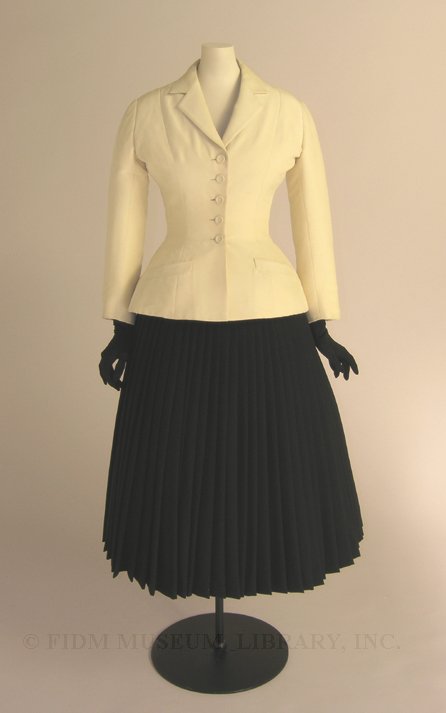Christian Dior's New Look at the FIDM Museum
With it's slope shouldered, close-fitting bodice, wasp waist and extravagantly full skirt, Christian Dior's New Look of 1947 is one of the most distinct and recognizable silhouettes of the twentieth century. In contrast to early 1940s feminine dress, which borrowed heavily from masculine military uniforms, the New Look exaggerated the curves and contours of the feminine form. To create this idealized female body, the New Look relied on a rigid framework of strategically placed padding and boning, not to mention corsets and petticoats. The full skirts of the New Look required a tremendous amount of fabric, up to 15 yards in some cases! After the restrictions and rationing of the World War II years, the New Look was scandalous in its extravagant usage of raw materials and in its presentation of the female body. Though perceived as shockingly new, the New Look was actually a return to physical ideals of the later nineteenth century and a continuation of a trend interrupted by World War II. Despite these precedents, when it appeared in 1947, the New Look was a watershed moment in fashion. Though other silhouettes achieved popularity in the 1950s, the New Look informed (either negatively or positively) all subsequent fashionable silhouettes through the 1960s.
The signature ensemble of the New Look was the Bar suit. A two-piece suit consisting of a pale, fitted jacket with narrow waist, padded hips and a black, mid-calf, knife pleated skirt--the famous mid-1950s image by Willy Maywald often serves as visual shorthand for the New Look. Though this suit was reportedly the best selling item from the first New Look collection, very few existing versions have found their way into museums. (If you happen to have a Bar suit hanging in the back of your closet, feel free to donate it to the FIDM Museum!) Though we don't have an original Bar suit in our collection, we are fortunate to have a replica Bar suit. Sewn from the original pattern pieces, it was donated to the FIDM Museum by Marc Bohan (then chief designer for Christian Dior) in 1981. Though many museums choose not to accession replica artifacts, we did so in the interest of research. Because we are affiliated with a teaching institution, this iconic garment is an important resource for students and faculty.

Reproduction of the Bar suit designed by Christian Dior
1981 from the 1947 design
Silk faille (jacket) and wool crepe (skirt)
Gift of Marc Bohan for Christian Dior
79.780.1AB
But there's more to the story! This is actually our second Bar suit. The first was donated in May 1979, also by Marc Bohan representing Christian Dior. This donation was in celebration of the 10th anniversary of FIDM, and was accompanied by a Christian Dior fashion show including historic and contemporary designs. Marc Bohan hosted the fashion show and FIDM students had an opportunity to attend a question and answer session with the designer. The donation of the replica Bar suit was one of the earliest to the FIDM Museum, which was founded in 1977.
During a Labor Day burglary at FIDM in 1981, our replica Bar suit was stolen, along with other items from throughout the campus. At the time, the campus and museum were housed in a different location from our current home. We've theorized that the suit was not stolen for its iconic status, but to cushion and/or wrap objects such as electronics. A FIDM spokesman interviewed by the Los Angeles Times soon after the theft stated, "In monetary terms...is priceless. The school is offering a reward leading to its return."1 Unfortunately, the stolen FIDM Bar suit was never recovered.
Luckily for us, Marc Bohan took pity on the FIDM Museum and donated another replica Bar suit in 1981. This second replica of the Bar suit was reputedly sewn by one of the seamstresses who worked on the original Bar suit in 1947. The jacket of our Bar suit bears a Christian Dior label and a smaller, hand-embroidered label reading "Genier." In all likelihood, this is the name of the seamstress who created our replica Bar suit.
Devotees of Christian Dior will notice that our version of the Bar suit has a notched collar. Other extant versions of the 1947 Bar suit usually have a shawl collar, though photographic evidence indicates that notched collar versions were produced. The question of a shawl vs. notched collar was probably a choice made by the wearer, as Christian Dior used both types of collars throughout his career.
We offer this story to our readers not as a criticism of former FIDM Museum staff, but as an interesting and entertaining anecdote regarding our history. It also points to the tremendous progress we have made as an institution. For example, our entire collection is now housed in a secured facility with restricted access making a theft of the type that robbed us of our first reproduction Bar suit impossible. Museums often limit behind-the-scenes access and information in the interest of presenting flawless research and exhibitions to the public. However, we all have areas in which there is room for improvement and growth and, even better, areas in which we have made great strides. This post about the Rudi Gernreich Archive details our progress in improving the organization and storage of an important resource.
We'd love to hear about successful projects which enhanced the storage, safety or condition of your institution's collection. Anyone willing to share?
1 "Listen." Los Angeles Times 12 Sept. 1980: J10.

